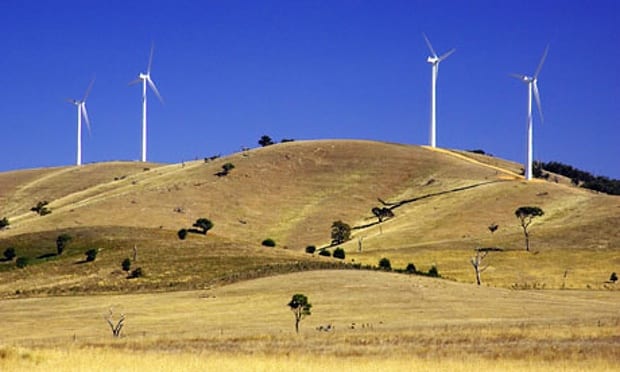
Based on analysis within our latest Renewables Report, Green Energy Markets has concluded that supply will fall short of the Large-scale Renewable Energy Target (RET) by 2018.
This will mean power retailers, and consequently their customers, will be paying the shortfall penalty (this is $65 for every megawatt-hour of renewable energy short of the target, which effectively works out to $92.86 because the penalty isn’t a tax deductible expense).
So how did it come to this? And what, if anything, should we do about it?
The first thing to note is that any shortfall is not for lack of renewable energy projects. Nor is the problem to do with the fundamental economics of those projects.
Rather, the shortfall is a product of wounded confidence in the finance community. That is quite understandable given that Dick Warburton, while chair of the Abbott Government review of the RET, told the Australian Financial Review the entire scheme could be scrapped (akin to cutting projects’ revenue in half) without a cent of compensation. On another occasion, Tony Abbott revealed to Alan Jones that he’d have liked to have scrapped the RET altogether.
A majority within the government baulked at such extreme measures, but it left financiers rattled. Such a battering to confidence can only be healed by positive experience and therefore the passage of time. Unfortunately, time is in short supply.
Back in late 2013, when financiers put a hold on renewable energy investment to await clarity about the Abbott Government’s policy, we knew there was a shortfall of renewable energy certificates awaiting in 2018.
Given the two year lag typically involved in financing and constructing renewable energy projects, things could have been OK if we’d resolved the uncertainty reasonably quickly, even if the target remained at 41 terrawatt-hours (TWh).
But by the time it was ultimately resolved in mid-2015 there was precious little time left, and financiers were fearfully cowering in their bunkers.
In April last year, Green Energy Markets estimated that an LRET target very similar to the 33TWh target that was ultimately enacted could be achieved provided the market committed investment to construct 1,200MW in 2015, which would need to be followed by another 2,500MW in 2016.
Unfortunately, the country committed to less than 500MW and most of that won’t even contribute towards the 33TWh target, instead being used by the ACT Government to count towards their own 90% renewable energy target.
In light of this, our December Renewables Report estimates 4,400MW would need to be committed in 2016 to avoid a shortfall in 2018. We’ve underestimated the ability of the renewables industry to deliver in the past but this turnaround appears inconceivable.
The price for Large-scale Renewable Energy Certificates known as LGCs suggests this is the consensus view of other participants.
Spot prices for LGCs have soared past the nominal shortfall penalty of $65 and are now in the low $80’s. Meanwhile some forward trades beyond 2017 have traded only a few dollars off the tax-effective level of the shortfall penalty of $92.86.

Such a price for LGCs is completely out of alignment with the underlying economics of large scale renewable energy projects. The ACT Government’s wind energy procurement auction managed to secure 3 projects at a cost of $81.50, $87 and $92 per MWh.
Taking the highest price of $92/MWh as a guide and given these projects would receive somewhere between $35 and $60 per MWh from selling the underlying electricity, this roughly implies a top up from LGCs of about $32 to $57 per certificate to make such projects viable. That’s an awful lot less than current spot prices.
The discrepancy between the market and economic fundamentals comes down to financiers’ lack of confidence about the long-term settings for the LRET. They’re prepared to build projects for the ACT Government for $81.50 to $92 per MWh because they don’t need to worry about what a future Federal Government might do with the LRET.
Confidence should recover over time provided the Federal Government resists the temptation to intervene in the market and the Environment Minister’s supportive statements about the scheme spread to other Cabinet Ministers.
However, over 2016 project commitments are likely to be mainly driven by state governments and government-owned retailers who are offering contracts that provide some long-term price certainty for project developers.
Our detailed assessment of these state government procurement initiatives, alongside ARENA’s large-scale solar auction, indicate 1100MWs could be committed this year. Coupled with some large behind the meter rooftop solar installations, it’s realistic to expect a break-out year for large-scale solar of more than 450MW in project commitments.
The figure of 1,100MW falls well short of what’s required to ensure the RET target is met in 2018 and also makes achievement of targets in subsequent years very challenging. But it is still a significant source of demand that will finally allow the renewables industry to regain their feet and rebuild their confidence.
It is no doubt deeply disappointing for everyone that Australia will fall short of the target, incurring unnecessarily high LGC prices and penalties when it could have been easily avoided. However if politicians start talking about tinkering with the scheme yet again, they’ll make things worse.
The current high LGC prices are acting to lure investors and power retailers out of their bunkers in spite of their wounds. Alinta’s tender for renewable energy and AGL’s 1000MW Powering Australian Renewables Fund announcement are promising signs.
Investment grade large power consumers are also wising up to the fact they’re paying too much for LGCs and could instead contract directly to support new projects. With time this will ultimately drive enough supply to overcome the shortfall and bring LGC prices down to levels in line with economic fundamentals.
Tristan Edis is Director – Analysis and Advisory for Green Energy Markets’ . He was previously Editor of Climate Spectator.







